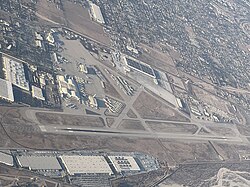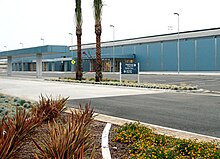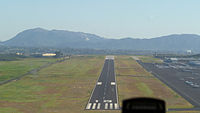San Bernardino International Airport | |||||||||||
|---|---|---|---|---|---|---|---|---|---|---|---|
 | |||||||||||
 | |||||||||||
| Summary | |||||||||||
| Airport type | Public | ||||||||||
| Owner | San Bernardino International Airport Authority (SBIAA) | ||||||||||
| Operator | SBIAA | ||||||||||
| Serves | San Bernardino / Inland Empire | ||||||||||
| Location | San Bernardino, California, United States | ||||||||||
| Hub for | Amazon Air[1] | ||||||||||
| Elevation AMSL | 1,159 ft / 353 m | ||||||||||
| Coordinates | 34°05′42″N 117°14′06″W / 34.095°N 117.235°W | ||||||||||
| Website | flysbd | ||||||||||
| Maps | |||||||||||
 FAA airport diagram | |||||||||||
 | |||||||||||
| Runways | |||||||||||
| |||||||||||
| Statistics (2023) | |||||||||||
| |||||||||||
San Bernardino International Airport (IATA: SBD, ICAO: KSBD, FAA LID: SBD) is a public airport two miles (3.2 km) southeast of downtown San Bernardino, California, in San Bernardino County, California, United States. The airport covers 1,329 acres (538 ha) and has one runway that can accommodate the largest existing aircraft, including the Airbus A380 and the Boeing 747.[5]
The facility is a commercial, general aviation, and cargo airport on the site of the former San Bernardino Municipal Airport, which was converted during World War II into the San Bernardino Air Depot in 1942 and which was subsequently renamed, "Norton Air Force Base", before being decommissioned with the fall of the Soviet Union.
San Bernardino International Airport encompasses three passenger terminals: a domestic terminal served by Breeze Airways, an international terminal with U.S. Customs and Border Protection processing facility, and the Luxivair SBD executive terminal, an airport-owned fixed-base operator.
History
[edit]The Norton Air Force Base opened shortly after the attacks on Pearl Harbor. Norton was placed on the Department of Defense's base closure list in 1989.
Most parts of San Bernardino International Airport were completed in 2011, though a customs facility was still under construction. San Bernardino International Airport was built to conform to aviation-demand modeling and allocations performed as part of the 2008 Regional Transportation Plan (RTP) of the Southern California Association of Governments (SCAG), the Metropolitan Planning Organization for San Bernardino, Los Angeles, Riverside, Ventura, Imperial, and Orange counties.
The RTP projected 9.4 million passengers and 1.29 million tons of air cargo at San Bernardino International Airport in 2035 with improved ground access provided, in part, by high-speed rail. The California High-Speed Rail Authority is currently performing alternatives analysis regarding the Los Angeles-to-San Diego segment, which includes, along the I-215 alignment, an optional station location at Rialto Avenue and E Street in the city of San Bernardino.
U.S. Customs and Border Protection agents are available on call to clear imported goods. The airport is used as a base for United States Forest Service planes fighting forest fires. Several hangars that were formerly empty have recently been occupied by civilian-owned aircraft maintenance companies.[citation needed] The runway is 10,000 feet (3,000 m) long, easily accommodating all commercial aircraft.
San Bernardino County grand jury and FBI investigations
[edit]An audit completed June 2011 at the request of a grand jury investigation found examples of potential mismanagement and financial irregularities.[6] In September 2011, as part of a special joint corruption task force, the FBI raided the offices of the airport and the home of airport developer Scot Spencer to secure internal documents.[7] In late September 2011, Don Rogers, the Director of the SBIA Authority (SBIAA) resigned.[8]
Launch of Commercial Passenger Service
[edit]
San Bernardino International Airport encompasses three passenger terminals: a domestic terminal served by Breeze Airways, an international terminal with a U.S. Customs and Border Protection processing facility, and the Luxivair SBD executive terminal, an airport-owned fixed-base operator.[9]
Volaris, a Mexican low-cost airline, announced the beginning of flights to Guadalajara, Mexico in November 2017; however, these plans were later cancelled.[10] In March 2022, Breeze Airways first announced plans to operate passenger service at the airport. Finally, on August 4, 2022,[11] Breeze Airways became the first commercial airline to operate passenger flights in and out of SBD's never-been-used domestic air terminal, with daily flights to San Francisco.
Airlines and destinations
[edit]Passenger
[edit]| Airlines | Destinations | Refs. |
|---|---|---|
| Breeze Airways | Provo (begins February 7, 2025),[12] San Francisco | [13] |
Cargo
[edit]| Airlines | Destinations |
|---|---|
| ABX Air | Allentown, Denver |
| Amazon Air | Allentown, Austin, Charlotte, Chicago/Rockford, Cincinnati, Hartford, Honolulu, Houston–Intercontinental, Kansas City, Minneapolis, New York–JFK, Seattle/Tacoma, Spokane, St. Louis, Tampa |
| FedEx Express | Colorado Springs, Memphis, Wichita |
| UPS Airlines | Chicago/Rockford, Dallas/Fort Worth, Denver, Fargo, Honolulu, Louisville, Oakland, Ontario, Portland (OR) Seasonal: Kahului |
Location
[edit]The airport and some of the surrounding area is within the city of San Bernardino and the Inland Valley Development Agency. The surrounding areas are being redeveloped by Hillwood.[14] The airport is about two miles east of downtown San Bernardino and 14 miles northeast of Riverside. It is six miles northwest of Redlands, on the outskirts of Highland. Motorists can use the San Bernardino Freeway (Interstate 10), Barstow Freeway (Interstate 215), or the Foothill Freeway.
Ground transportation
[edit]The Omnitrans route 15 bus connects from North Del Rosa Drive and East Rialto Street to the San Bernardino Transit Center, where Metrolink connections are available to several locations including Los Angeles Union Station.
In popular culture
[edit]The airport was the filming location for the 1996 movie Executive Decision, the 2001 movie The Fast and the Furious and the 2004 Martin Scorsese film The Aviator using a Lockheed Constellation preserved by the National Airline History Museum, and flown in for the shoot, with one hangar "dressed" as a Trans World Airlines facility.[15][16]
References
[edit]- ^ "Amazon begins operations at San Bernardino airport hub". April 29, 2021.
- ^ "SAN BERNARDINO INTERNATIONAL AIRPORT AUTHORITY REGULAR MEETING AGENDA WEDNESDAY, JANUARY 24, 2024". SAN BERNARDINO INTERNATIONAL AIRPORT AUTHORITY. Retrieved July 27, 2024.
- ^ "SAN BERNARDINO INTERNATIONAL AIRPORT AUTHORITY REGULAR MEETING AGENDA WEDNESDAY, JANUARY 24, 2024". SAN BERNARDINO INTERNATIONAL AIRPORT AUTHORITY. Retrieved July 27, 2024.
- ^ "Annual Report – San Bernardino International Airport (SBD)". June 4, 2022. Retrieved October 20, 2022.
- ^ a b FAA Airport Form 5010 for SBD PDF, effective March 30, 2017
- ^ Grand Jury. "2011-2012 Final Report" (PDF). County of San Bernardino. Retrieved January 6, 2015.
- ^ Willon, Phil (September 21, 2011). "FBI raids San Bernardino airport agency as part of investigation". Los Angeles Times. Retrieved April 11, 2013.
- ^ Dulaney, Josh (September 28, 2011). "San Bernardino airport director resigns". The San Bernardino Sun. Retrieved April 11, 2013.
- ^ "Passenger Services". San Bernardino International Airport. Retrieved April 3, 2017.
- ^ "Volaris – Select your flight – San Bernardino to Guadalajara" (Web). Volaris. Retrieved April 2, 2017.
- ^ Gilbertson, Dawn (March 8, 2022). "Breeze Airways wants a piece of your summer vacation budget with these 35 new routes across US". USA Today.
- ^ "Breeze Airways Strengthens U.S. Network with Bold Nonstop Route to Provo-Salt Lake City: What You Need To Know". Travel and Tour World. December 12, 2024. Retrieved December 13, 2024.
- ^ "Destinations: San Bernardino". Breeze Airways. Retrieved April 23, 2023.
- ^ "AllianceCalifornia Overview" (PDF). Hillwood investments. Hillwood. Retrieved July 27, 2024.
- ^ Denning, Larry; Albright, Dave. "Connie at the Movies". Airline History Museum. Archived from the original on February 25, 2012. Retrieved April 11, 2013.
- ^ "Picture of the Lockheed L-1049H/01 Super Constellation aircraft". Airliners.net. Retrieved April 11, 2013.
External links
[edit]- Official website
- FAA Airport Form 5010 for SBD PDF
- FAA Airport Diagram (PDF), effective December 26, 2024
- Resources for this airport:
- FAA airport information for SBD
- AirNav airport information for KSBD
- ASN accident history for SBD
- FlightAware airport information and live flight tracker
- NOAA/NWS weather observations: current, past three days
- SkyVector aeronautical chart, Terminal Procedures

